Kuppan T. Heat Exchanger Design Handbook
Подождите немного. Документ загружается.

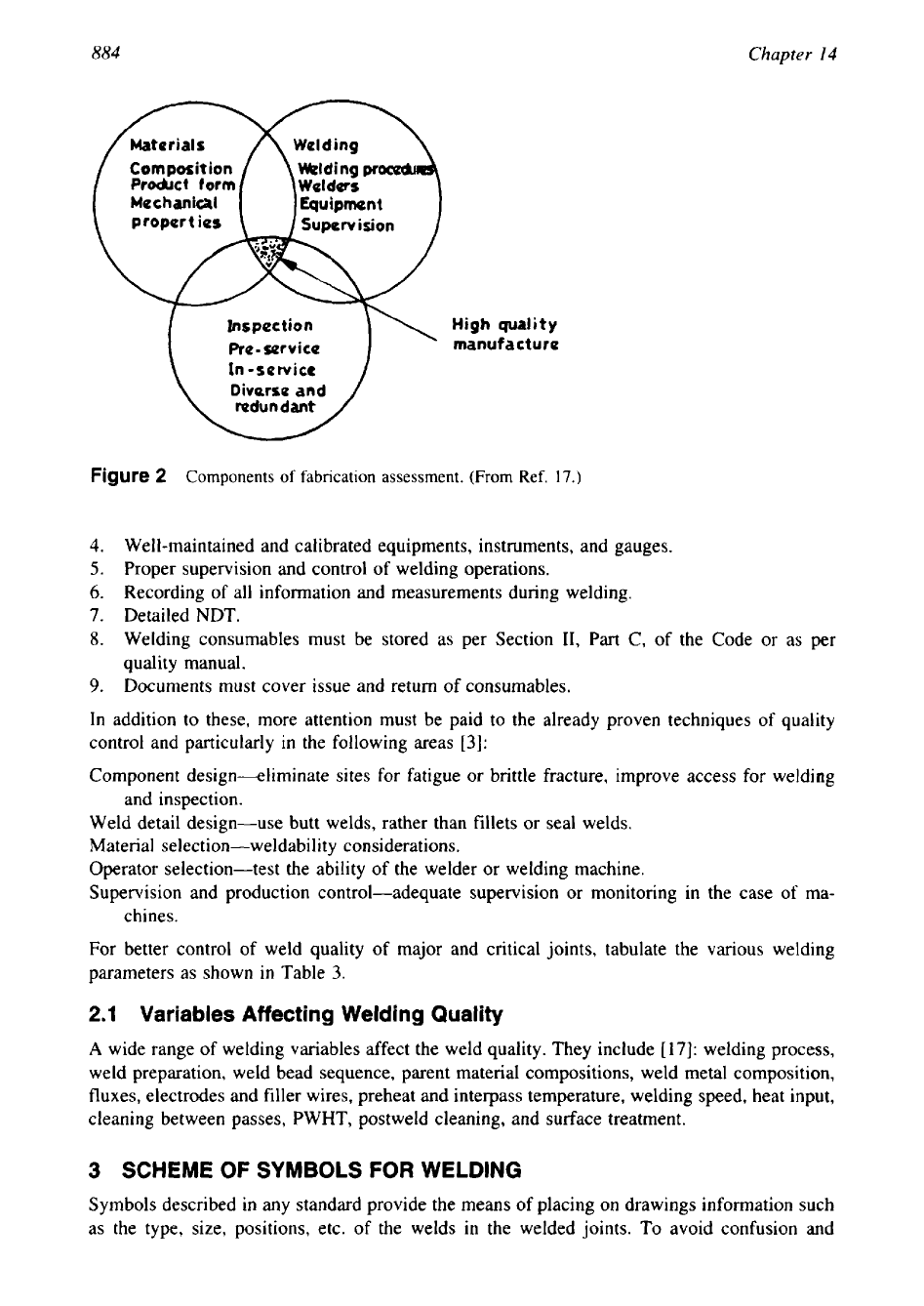
884
Chapter
14
Mechanical
Inspection
\
High
quality
Re-
service
man
u
f
a
c
t
u
r
a
In
-sewice
Divarsa
and
redundant
U
Figure
2
Components of fabrication assessment. (From Ref.
17.)
4.
Well-maintained and calibrated equipments, instruments, and gauges.
5.
Proper supervision and control of welding operations.
6.
Recording of all information and measurements during welding.
7.
Detailed NDT.
8.
Welding consumables must be stored as per Section
11,
Part C,
of
the Code or as per
quality manual.
9.
Documents must cover issue and return of consumables.
In
addition to these, more attention must be paid to the already proven techniques of quality
control and particularly in the following areas
[3]:
Component design-eliminate sites for fatigue or brittle fracture, improve access for welding
and inspection.
Weld detail design-use butt welds, rather than fillets or seal welds.
Material selection-weldability considerations.
Operator selection-test the ability of the welder or welding machine.
Supervision and production control-adequate supervision or monitoring in the case of ma-
chines.
For better control of weld quality of major and critical joints, tabulate the various welding
parameters as shown in Table
3.
2.1
Variables Affecting Welding Quality
A
wide range
of
welding variables affect the weld quality. They include
[
171:
welding process,
weld preparation, weld bead sequence, parent material compositions, weld metal composition,
fluxes, electrodes and filler wires, preheat and interpass temperature, welding speed, heat input,
cleaning between passes, PWHT, postweld cleaning, and surface treatment.
3
SCHEME
OF SYMBOLS
FOR
WELDING
Symbols described in any standard provide the means of placing
on
drawings information such
as the type, size, positions, etc. of the welds in the welded joints. To avoid confusion and
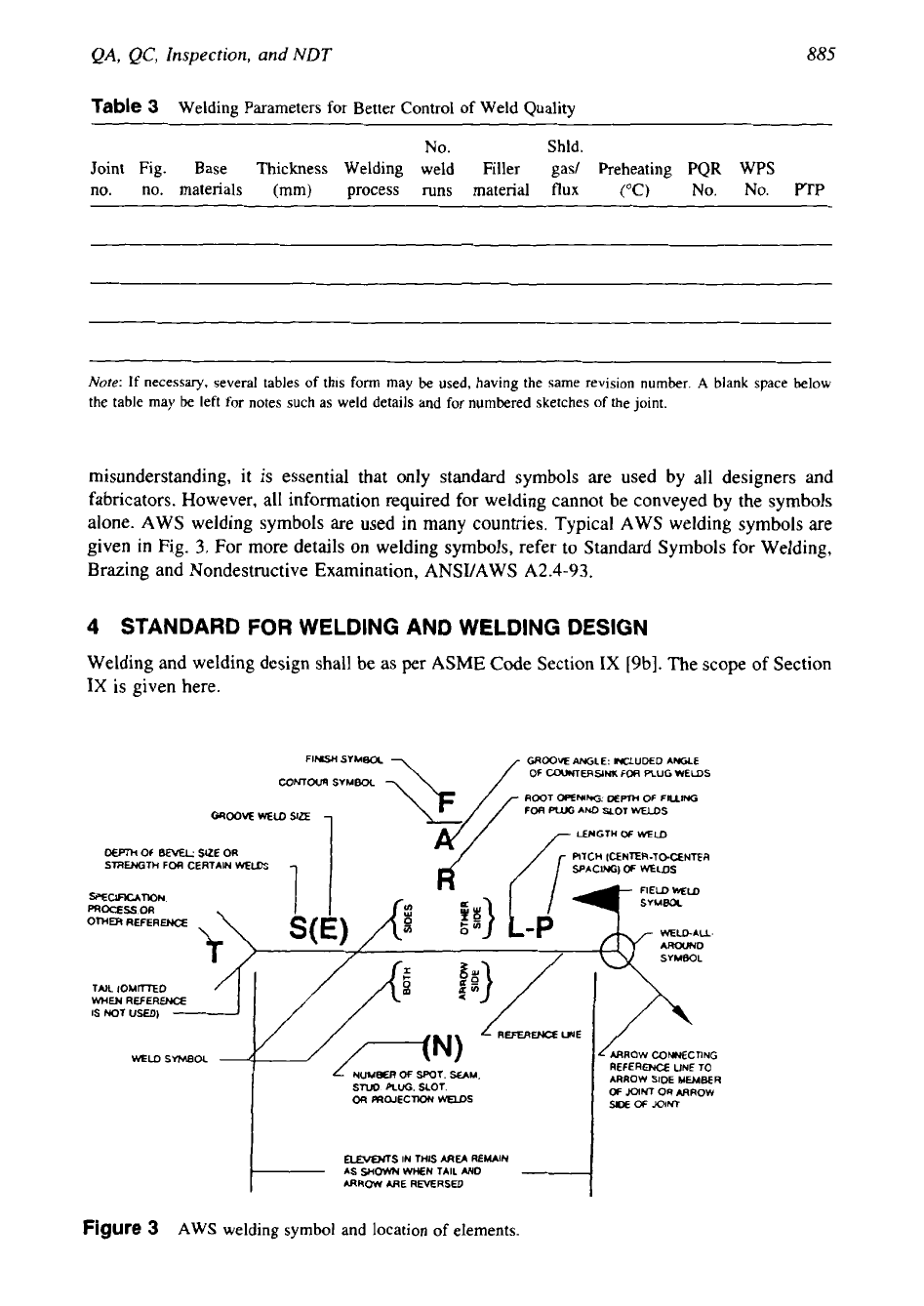
QA,
QC,
Inspection,
and
NDT
885
Table
3
Welding Parameters for Better Control of Weld Quality
No.
Shld.
Joint
Fig. Base
Thickness Welding weld Filler gas/
Reheating
PQR WPS
no. no.
materials
(mm) process
runs
material
flux
("C)
No. No.
PTP
Nore:
If necessary, several tables of this form may be used, having the same revision number.
A
blank space below
the table may be left for notes such as weld details and for numbered sketches of the joint.
misunderstanding, it is essential that only standard symbols are used by all designers and
fabricators. However, all information required for welding cannot be conveyed by the symbols
alone. AWS welding symbols are used in many countries. Typical AWS welding symbols are
given in Fig.
3.
For more details on welding symbols, refer to Standard Symbols
for
Welding,
Brazing and Nondestructive Examination, ANSVAWS A2.4-93.
4
STANDARD
FOR
WELDING AND WELDING DESIGN
Welding and welding design shall be as
per
ASME
Code Section
IX
[9b]. The scope
of
Section
IX
is
given here.
GROOM
ANGLE:
IWXUDED
ANGLE
OF
COUNTERSINK
FOR
RUG
WELDS
ROOT
OPENING:
MPIH
OF
FIUING
FOCI
RUG
AN0
SLOT
W S
GROOVE
MU)
SlzE
LWCTH
OF
WELD
DWW
Of
BML:
SIZE
OR
PITCH
(CENTER-TO-CENTER
STRENGTH
FOR
CERTAIN
WELDS
SPAClNG)
OF
WELDS
SP€ClFKAl-lON.
PROCESS.OR
OTHER
REFERIWCE
TAJL
IOMTED
WHEN
REFERENCE
IS
NOT
USED)
REFERENCE
ME
WELD
SYMBOL
REFERENCE
UN€
TO
STUO
RUG.SLOT.
OR
mcaxcnoN
WELDS
ARROW
SIDE
MEMBER
OF
JOINT
OR
ARROW
SlDE
OF
JOINT
ELENWS
IN
THIS
AREA
REMAIN
AS
SHOW
WHEN
TAIL
AND
t-
ARROW
ARE
REVERSED
Figure
3
AWS
welding symbol
and
location
of
elements.
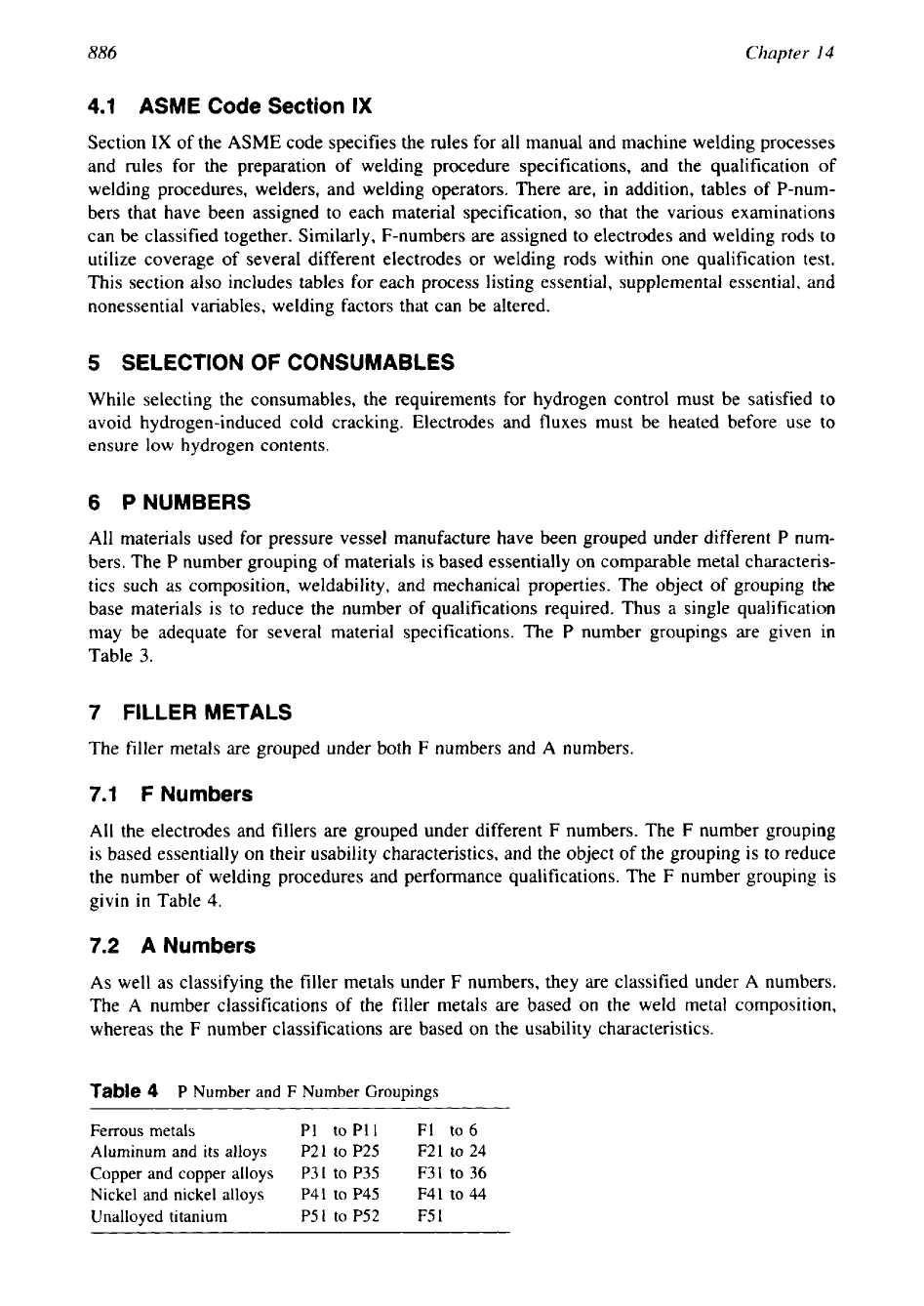
886
Chapter
14
4.1
ASME Code Section
IX
Section
IX
of the ASME code specifies the rules for all manual and machine welding processes
and rules for the preparation of welding procedure specifications, and the qualification
of
welding procedures, welders, and welding operators. There are, in addition, tables of P-num-
bers that have been assigned to each material specification,
so
that the various examinations
can be classified together. Similarly, F-numbers are assigned to electrodes and welding rods to
utilize coverage of several different electrodes or welding rods within one qualification test.
This section also includes tables for each process listing essential, supplemental essential, and
nonessential variables, welding factors that can be altered.
5 SELECTION
OF
CONSUMABLES
While selecting the consumables, the requirements for hydrogen control must be satisfied to
avoid hydrogen-induced cold cracking. Electrodes and fluxes must be heated before use to
ensure low hydrogen contents.
6
PNUMBERS
All materials used for pressure vessel manufacture have been grouped under different
P
num-
bers. The
P
number grouping of materials is based essentially on comparable metal characteris-
tics such as composition, weldability, and mechanical properties. The object of grouping
the
base materials is
to
reduce the number of qualifications required. Thus
a
single qualification
may be adequate for several material specifications. The
P
number groupings are given
in
Table
3.
7
FILLER METALS
The filler metals are grouped under both
F
numbers and A numbers.
7.1
F
Numbers
All the electrodes and fillers are grouped under different
F
numbers. The
F
number grouping
is based essentially on their usability characteristics, and the object of the grouping is to reduce
the number of welding procedures and performance qualifications. The
F
number grouping is
givin in Table
4.
7.2
A
Numbers
As
well as classifying the filler metals under
F
numbers, they are classified under
A
numbers.
The A number classifications of the filler metals are based on the weld metal composition,
whereas the
F
number classifications are based on the usability characteristics.
Table
4
P
Number and F Number Groupings
Ferrous metals
PI top11
Fl to6
Aluminum and its alloys
P21
to
P25
F21
to
24
Copper and copper alloys
P31
to
P35 F31
to
36
Nickel
and
nickel alloys
P41
to
P45
F41
to
44
Unalloyed titanium
P51
to
P52
F51
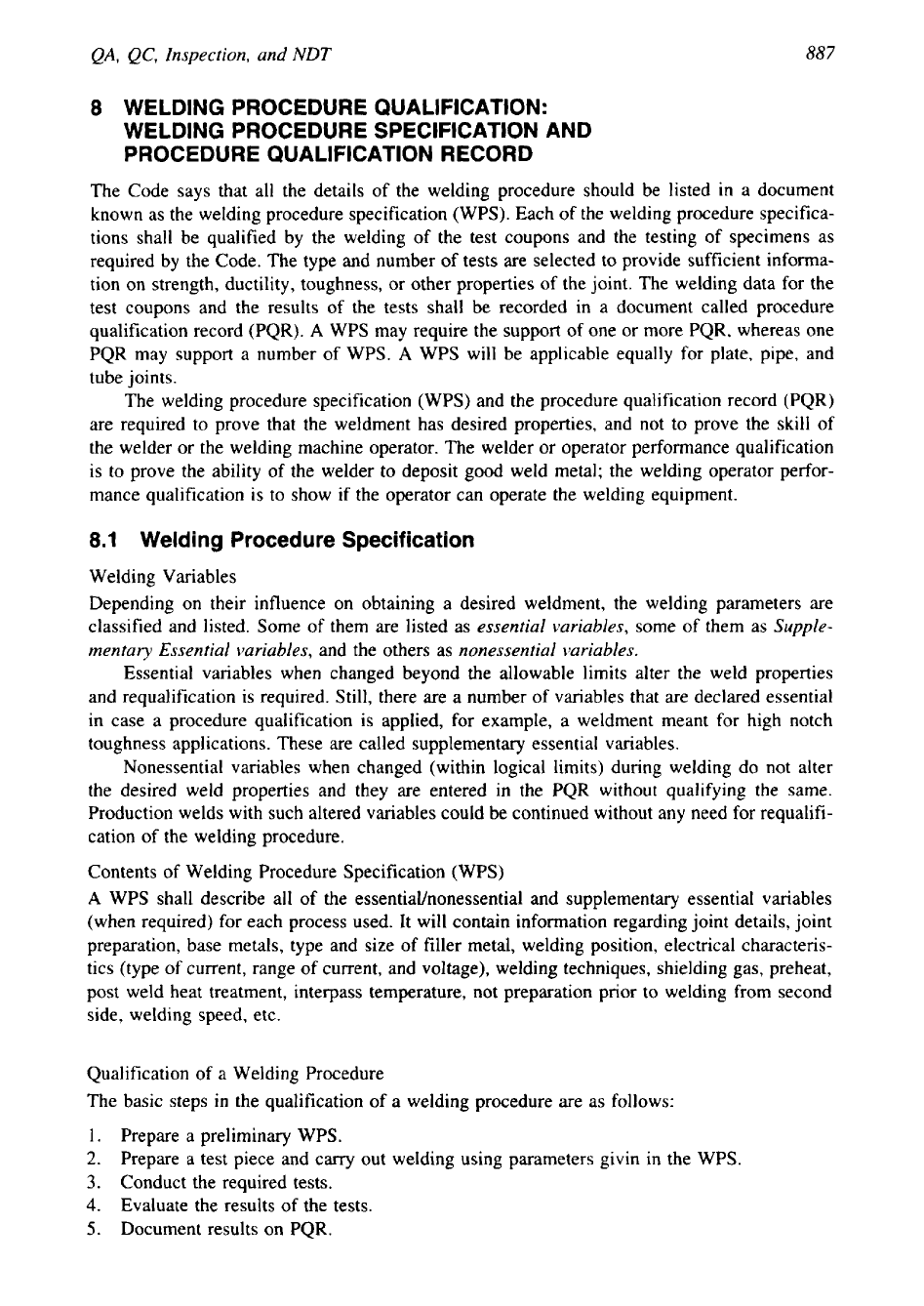
QA,
QC,
Inspection, and
NDT
887
8
WELDING PROCEDURE QUALIFICATION:
WELDING PROCEDURE SPECIFICATION AND
PROCEDURE QUALIFICATION RECORD
The Code says that all the details of the welding procedure should be listed in a document
known as the welding procedure specification (WPS). Each of the welding procedure specifica-
tions shall be qualified by the welding of the test coupons and the testing of specimens as
required by the Code. The type and number of tests are selected to provide sufficient informa-
tion on strength, ductility, toughness, or other properties of the joint. The welding data for the
test coupons and the results of the tests shall be recorded in a document called procedure
qualification record (PQR).
A
WPS may require the support of one or more PQR, whereas one
PQR may support a number of WPS.
A
WPS will be applicable equally for plate, pipe, and
tube joints.
The welding procedure specification (WPS) and the procedure qualification record (PQR)
are required
to
prove that the weldment has desired properties, and not to prove the skill of
the welder or the welding machine operator. The welder or operator performance qualification
is to prove the ability of the welder to deposit good weld metal; the welding operator perfor-
mance qualification is to show if the operator can operate the welding equipment.
8.1
Welding Procedure Specification
Welding Variables
Depending on their influence on obtaining a desired weldment, the welding parameters are
classified and listed. Some of them are listed as
essential variables,
some of them as
Suppie-
mentary Essential variables,
and the others as
nonessential variables.
Essential variables when changed beyond the allowable limits alter the weld properties
and requalification is required. Still, there are a number
of
variables that are declared essential
in case a procedure qualification is applied, for example, a weldment meant for high notch
toughness applications. These are called supplementary essential variables.
Nonessential variables when changed (within logical limits) during welding do not alter
the desired weld properties and they are entered in the PQR without qualifying the same.
Production welds with such altered variables could be continued without any need for requalifi-
cation of the welding procedure.
Contents of Welding Procedure Specification (WPS)
A
WPS
shall describe all of the essentialhonessential and supplementary essential variables
(when required)
for
each process used. It will contain information regarding joint details, joint
preparation, base metals, type and size of filler metal, welding position, electrical characteris-
tics (type
of
current, range of current, and voltage), welding techniques, shielding gas, preheat,
post weld heat treatment, interpass temperature, not preparation prior to welding from second
side, welding speed, etc.
Qualification of a Welding Procedure
The basic steps in the qualification of a welding procedure are as follows:
1.
Prepare a preliminary
WPS.
2.
Prepare a test piece and carry out welding using parameters givin in the WPS.
3.
Conduct the required tests.
4.
Evaluate the results of the tests.
5.
Document results on PQR.
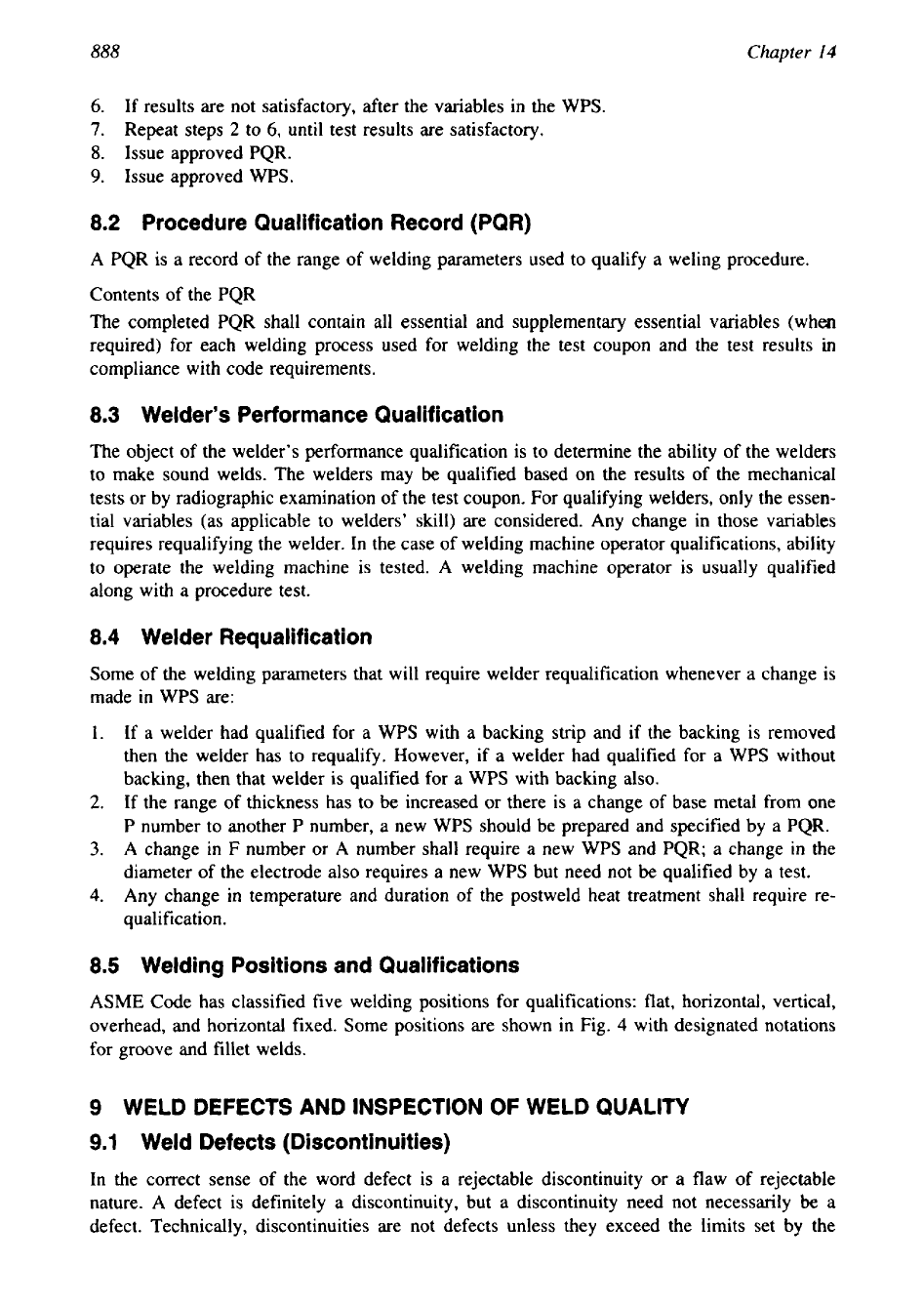
888
Chapter
I4
6.
If results are not satisfactory, after the variables in the WPS.
7.
Repeat steps
2
to
6,
until test results are satisfactory.
8.
Issue approved PQR.
9.
Issue approved WPS.
8.2
Procedure Qualification Record (PQR)
A PQR is a record of the range of welding parameters used to qualify a weling procedure.
Contents of the PQR
The completed PQR shall contain all essential and supplementary essential variables (when
required) for each welding process used for welding the test coupon and the test results
in
compliance with code requirements.
8.3
Welder’s Performance Qualification
The object of the welder’s performance qualification is to determine the ability of the welders
to make sound welds. The welders may be qualified based on the results of the mechanical
tests or by radiographic examination of the test coupon. For qualifying welders, only the essen-
tial variables (as applicable to welders’ skill) are considered. Any change in those variables
requires requalifying the welder. In the case of welding machine operator qualifications, ability
to operate the welding machine is tested. A welding machine operator is usually qualified
along with a procedure test.
8.4
Welder Requalification
Some of the welding parameters that will require welder requalification whenever a change is
made in WPS are:
1.
If a welder had qualified for a WPS with a backing strip and if the backing is removed
then the welder has
to
requalify. However, if a welder had qualified for a WPS without
backing, then that welder is qualified for a
WPS
with backing also.
2.
If the range of thickness has to be increased or there is a change of base metal from one
P number to another P number, a new WPS should be prepared and specified by a PQR.
3.
A change in F number or
A
number shall require a new WPS and PQR; a change
in
the
diameter of the electrode also requires
a
new WPS but need not be qualified by a test.
4.
Any change in temperature and duration of the postweld heat treatment shall require re-
qualification.
8.5
Welding Positions and Qualifications
ASME
Code has classified five welding positions for qualifications: flat, horizontal, vertical,
overhead, and horizontal fixed. Some positions are shown in Fig.
4
with designated notations
for groove and fillet welds.
9
WELD DEFECTS AND INSPECTION
OF
WELD QUALITY
9.1
Weld Defects (Discontinuities)
In the correct sense of the word defect
is
a rejectable discontinuity or a flaw of rejectable
nature. A defect is definitely a discontinuity, but a discontinuity need not necessarily be a
defect. Technically, discontinuities are not defects unless they exceed the limits set by the

889
QA,
QC,
Inspection,
and
NDT
6@v9fl
2G
3G
20
Axis
of
weld
1F
2F
3F
4F
Figure
4
Welding positions for qualification.
(a)
Groove welds in pipe, and
(b)
fillet welds in plate.
(Reproduced from Ref.
9.)
codes or standards have specified
[24].
Discontinuities may be found in weld metal, heat-
affected zones, and base metal.
9.2
Causes
of
Discontinuities
Defects are caused due
to
inferior design, poor workmanship, wrong welding procedure,
poor
weldability
of
the materials, etc.
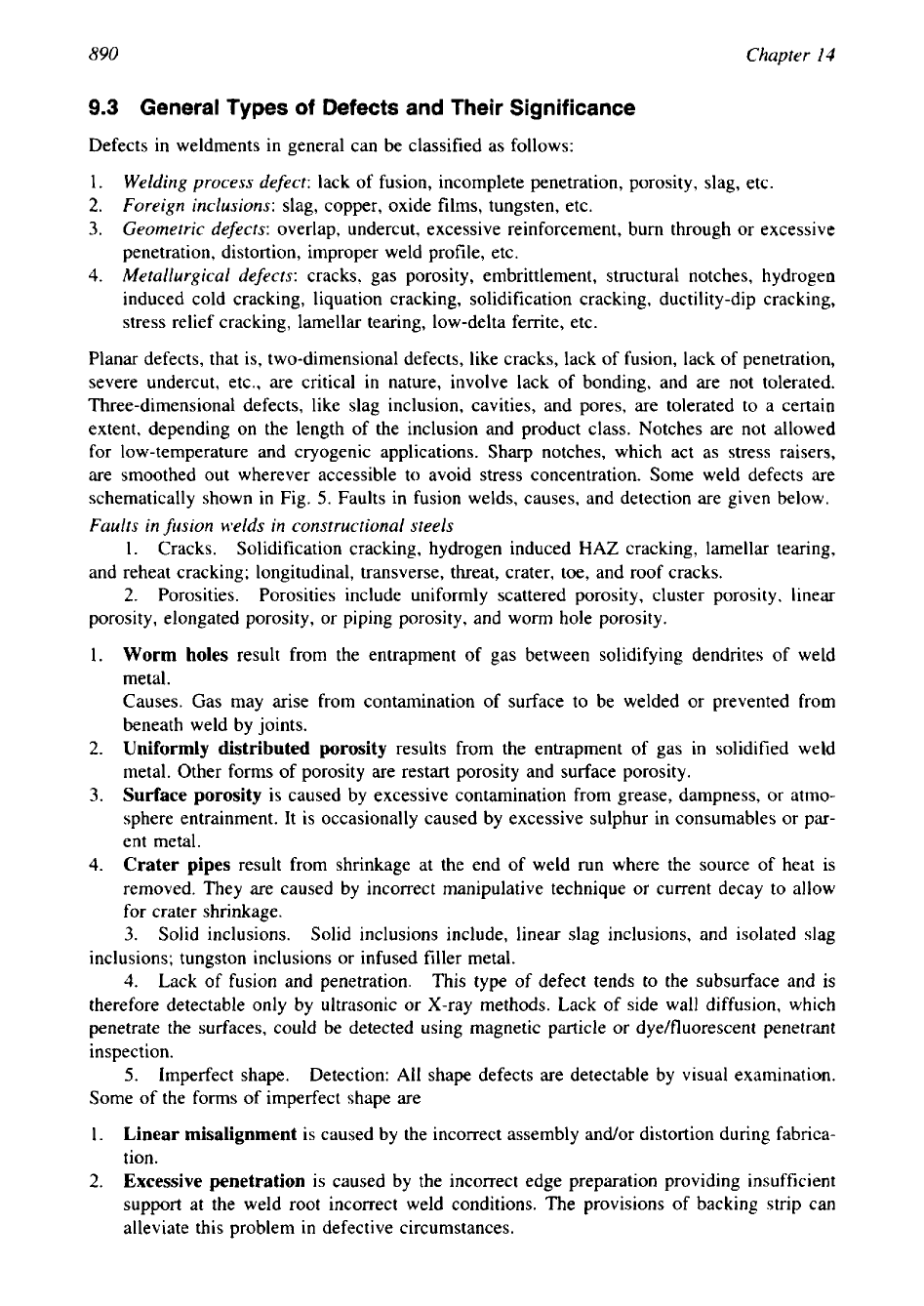
890
Chapter 14
9.3
General Types of Defects and Their Significance
Defects in weldments in general can be classified as follows:
1.
Welding process defect:
lack of fusion, incomplete penetration, porosity, slag, etc.
2.
Foreign inclusions:
slag, copper, oxide films, tungsten, etc.
3.
Geometric defects:
overlap, undercut, excessive reinforcement, burn through or excessive
penetration, distortion, improper weld profile, etc.
4.
Metallurgical defects:
cracks, gas porosity, embrittlement, structural notches, hydrogen
induced cold cracking, liquation cracking, solidification cracking, ductility-dip cracking,
stress relief cracking, lamellar tearing, low-delta ferrite, etc.
Planar defects, that is, two-dimensional defects, like cracks, lack of fusion, lack of penetration,
severe undercut, etc., are critical in nature, involve lack of bonding, and are not tolerated.
Three-dimensional defects, like slag inclusion, cavities, and pores, are tolerated to a certain
extent, depending on the length of the inclusion and product class. Notches are not allowed
for low-temperature and cryogenic applications. Sharp notches, which act as stress raisers,
are smoothed out wherever accessible to avoid stress concentration. Some weld defects are
schematically shown in Fig.
5.
Faults
in
fusion welds, causes, and detection are given below.
Faults in fitsion welds in constructional steels
1.
Cracks. Solidification cracking, hydrogen induced
HAZ
cracking, lamellar tearing,
and reheat cracking; longitudinal, transverse, threat, crater, toe, and roof cracks.
2.
Porosities. Porosities include uniformly scattered porosity, cluster porosity, linear
porosity, elongated porosity, or piping porosity, and worm hole porosity.
Worm holes
result from the entrapment of gas between solidifying dendrites of weld
metal.
Causes. Gas may arise from contamination of surface to be welded or prevented from
beneath weld by joints.
Uniformly distributed porosity
results from the entrapment of gas in solidified weld
metal. Other forms of porosity are restart porosity and surface porosity.
Surface porosity
is caused by excessive contamination from grease, dampness, or atmo-
sphere entrainment. It is occasionally caused by excessive sulphur in consumables or par-
ent metal.
Crater pipes
result from shrinkage at the end of weld run where the source of heat is
removed. They are caused by incorrect manipulative technique or current decay to allow
for crater shrinkage.
3.
Solid inclusions. Solid inclusions include, linear slag inclusions, and isolated slag
inclusions; tungston inclusions or infused filler metal.
4.
Lack of fusion and penetration. This type
of defect tends to the subsurface and
is
therefore detectable only by ultrasonic or X-ray methods. Lack of side wall diffusion, which
penetrate the surfaces, could be detected using magnetic particle or dye/fluorescent penetrant
inspection.
5.
Imperfect shape.
Detection: All shape defects are detectable by visual examination.
Some of the forms of imperfect shape are
1.
Linear misalignment
is caused by the incorrect assembly andor distortion during fabrica-
tion.
2.
Excessive penetration
is caused by the incorrect edge preparation providing insufficient
support at the weld root incorrect weld conditions. The provisions of backing strip can
alleviate this problem in defective circumstances.
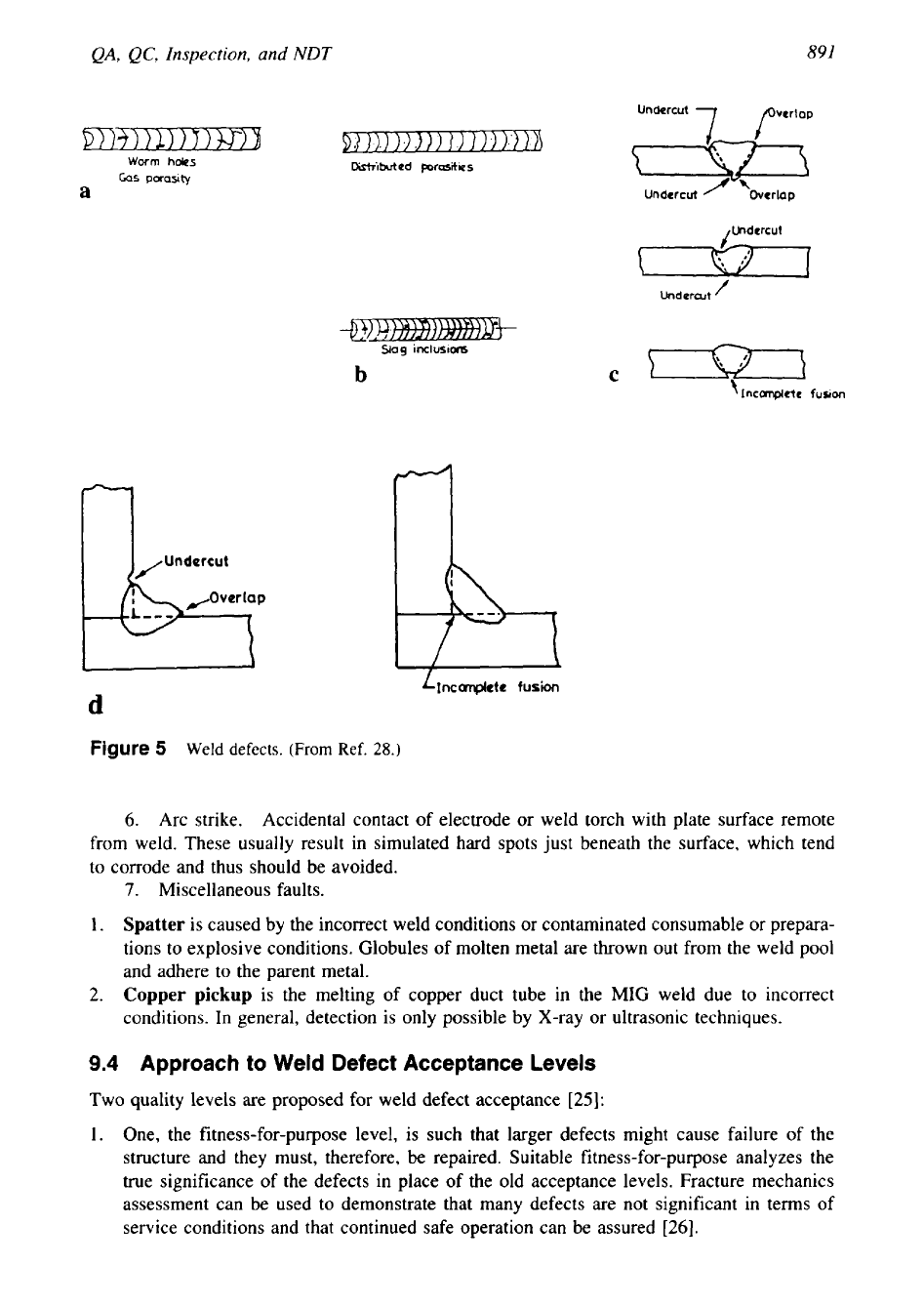
891
QA,
QC,
Inspection,
and
NDT
Undercut
1
perlop
Worm
holes
Gas
paasity
a
Undercut Overlap
Undercut
f
Sag
inclusiom
\-Q-\
b
C
f
~ncarrp~ete
fusion
n
d
Figure
5
Weld defects.
(From
Ref.
28.)
6.
Arc strike.
Accidental contact of electrode or weld torch with plate surface remote
from weld. These usually result in simulated hard spots just beneath the surface, which tend
to corrode and thus should be avoided.
7.
Miscellaneous faults.
1.
Spatter
is caused by the incorrect weld conditions or contaminated consumable or prepara-
tions to explosive conditions. Globules of molten metal are thrown out from the weld pool
and adhere to the parent metal.
2.
Copper pickup
is
the melting of copper duct tube in the
MIG
weld due to incorrect
conditions. In general, detection is only possible by X-ray or ultrasonic techniques.
9.4
Approach to Weld Defect Acceptance Levels
Two quality levels are proposed for weld defect acceptance
[25]:
1.
One, the fitness-for-purpose level, is such that larger defects might cause failure of the
structure and they must, therefore, be repaired. Suitable fitness-for-purpose analyzes the
true significance of the defects in place of the old acceptance levels. Fracture mechanics
assessment can be used to demonstrate that many defects are not significant in terms of
service conditions and that continued safe operation can be assured
[26].
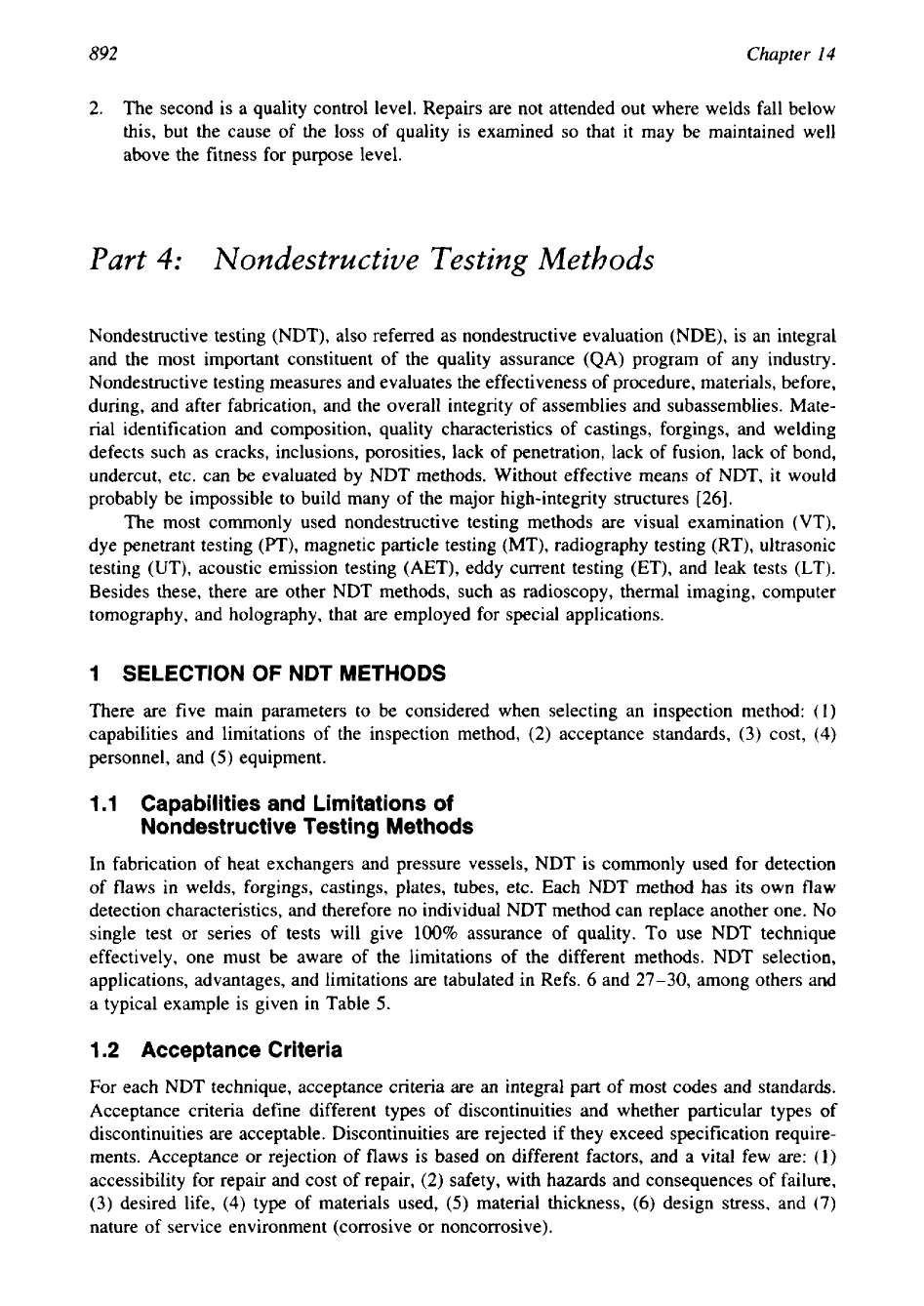
892
Chapter
14
2. The second is a quality control level. Repairs are not attended out where welds fall below
this, but the cause of the loss of quality is examined
so
that it may be maintained well
above the fitness for purpose level.
Part
4:
Nondestructive Testing Methods
Nondestructive testing (NDT), also referred as nondestructive evaluation (NDE), is an integral
and the most important constituent of the quality assurance (QA) program of any industry.
Nondestructive testing measures and evaluates the effectiveness of procedure, materials, before,
during, and after fabrication, and the overall integrity of assemblies and subassemblies. Mate-
rial identification and composition, quality characteristics of castings, forgings, and welding
defects such as cracks, inclusions, porosities, lack of penetration, lack of fusion, lack of bond,
undercut, etc. can be evaluated by NDT methods. Without effective means of NDT, it would
probably be impossible to build many of the major high-integrity structures [26].
The most commonly used nondestructive testing methods are visual examination
(VT),
dye penetrant testing
(PT),
magnetic particle testing (MT), radiography testing (RT), ultrasonic
testing (UT), acoustic emission testing (AET), eddy current testing (ET), and leak tests (LT).
Besides these, there are other NDT methods, such as radioscopy, thermal imaging, computer
tomography, and holography, that are employed for special applications.
1
SELECTION
OF
NDT METHODS
There are five main parameters to be considered when selecting an inspection method:
(1)
capabilities and limitations of the inspection method, (2) acceptance standards,
(3)
cost,
(4)
personnel, and
(5)
equipment.
1
.I
Capabilities and Limitations
of
Nondestructive Testing Methods
In fabrication of heat exchangers and pressure vessels, NDT is commonly used for detection
of flaws in welds, forgings, castings, plates, tubes, etc. Each NDT method has its own flaw
detection characteristics, and therefore no individual NDT method can replace another one. No
single test or series
of
tests will give
100%
assurance of quality. To use NDT technique
effectively, one must be aware of the limitations of the different methods. NDT selection,
applications, advantages, and limitations are tabulated in Refs. 6 and 27-30, among others and
a typical example is given in Table
5.
1.2
Acceptance Criteria
For each NDT technique, acceptance criteria are an integral part of most codes and standards.
Acceptance criteria define different types of discontinuities and whether particular types of
discontinuities are acceptable. Discontinuities are rejected if they exceed specification require-
ments. Acceptance
or
rejection of flaws is based on different factors, and a vital few are:
(1)
accessibility for repair and cost of repair,
(2)
safety, with hazards and consequences of failure,
(3)
desired life,
(4)
type of materials used,
(5)
material thickness, (6) design stress, and
(7)
nature of service environment (corrosive
or
noncorrosive).
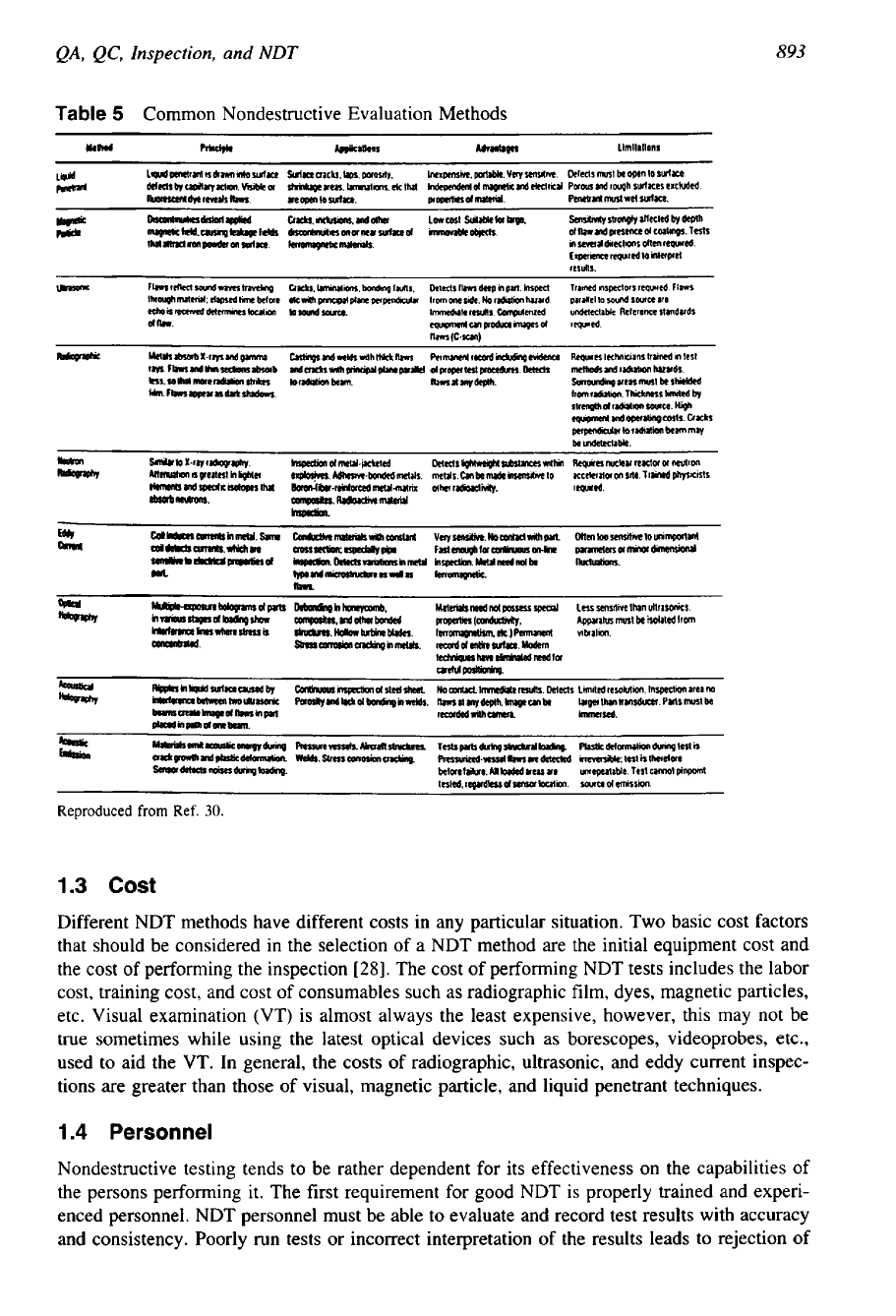
893
QA,
QC,
Inspection,
and
NDT
Table
5 Common Nondestructive Evaluation Methods
1.3
Cost
Different NDT methods have different costs in any particular situation. Two basic cost factors
that should be considered in the selection of a NDT method are the initial equipment cost and
the cost of performing the inspection
[28].
The cost of performing NDT tests includes the labor
cost, training cost, and cost of consumables such as radiographic film, dyes, magnetic particles,
etc. Visual examination (VT) is almost always the least expensive, however, this may not be
true sometimes while using the latest optical devices such as borescopes, videoprobes, etc.,
used to aid the VT.
In
general, the costs of radiographic, ultrasonic, and eddy current inspec-
tions are greater than those of visual, magnetic particle, and liquid penetrant techniques.
1.4
Personnel
Nondestructive testing tends to be rather dependent for its effectiveness on the capabilities of
the persons performing it. The first requirement for good NDT is properly trained and experi-
enced personnel. NDT personnel must be able to evaluate and record test results with accuracy
and consistency. Poorly run tests or incorrect interpretation of the results leads to rejection
of
